COIT20271 - Mobile Game Development: Slither.io Analysis
VerifiedAdded on 2022/08/14
|8
|2110
|16
Essay
AI Summary
This essay provides a comprehensive analysis of the mobile game Slither.io, examining its various aspects. The essay begins with an introduction to the game and proceeds to discuss game mechanics, including points, levels, missions, and leaderboards. It then delves into the game's usability, highlighting its user-friendly design and engaging features. The analysis further explores game design patterns and how they contribute to the game's challenges and player engagement. The essay also addresses playability heuristics, evaluating the game based on factors like time efficiency, consideration of interruptions, and ease of understanding. The context of the game, including its objective and gameplay, is also discussed, followed by a conclusion summarizing the key findings. The essay utilizes references to support the analysis, providing a well-rounded examination of Slither.io.
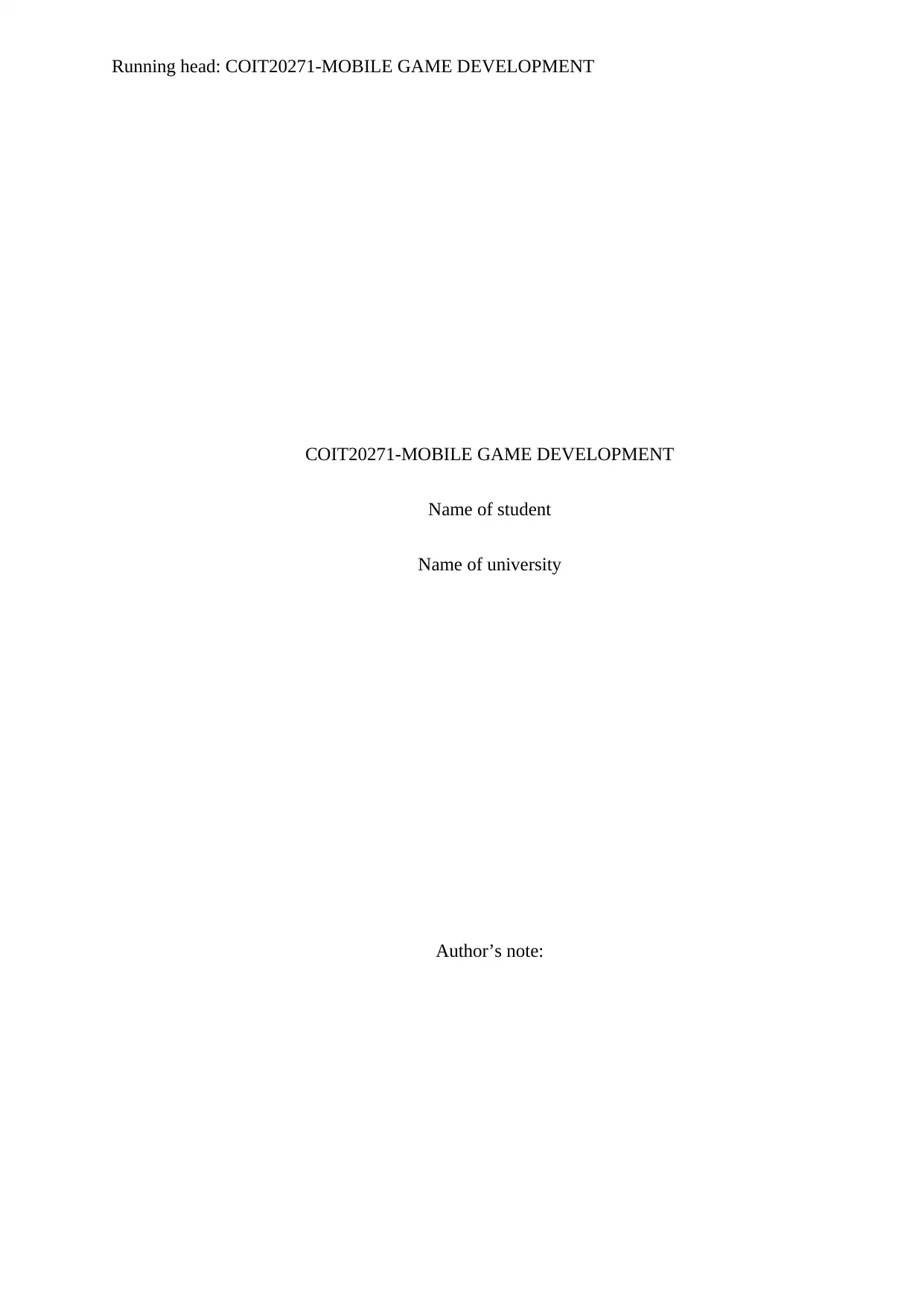
Running head: COIT20271-MOBILE GAME DEVELOPMENT
COIT20271-MOBILE GAME DEVELOPMENT
Name of student
Name of university
Author’s note:
COIT20271-MOBILE GAME DEVELOPMENT
Name of student
Name of university
Author’s note:
Paraphrase This Document
Need a fresh take? Get an instant paraphrase of this document with our AI Paraphraser
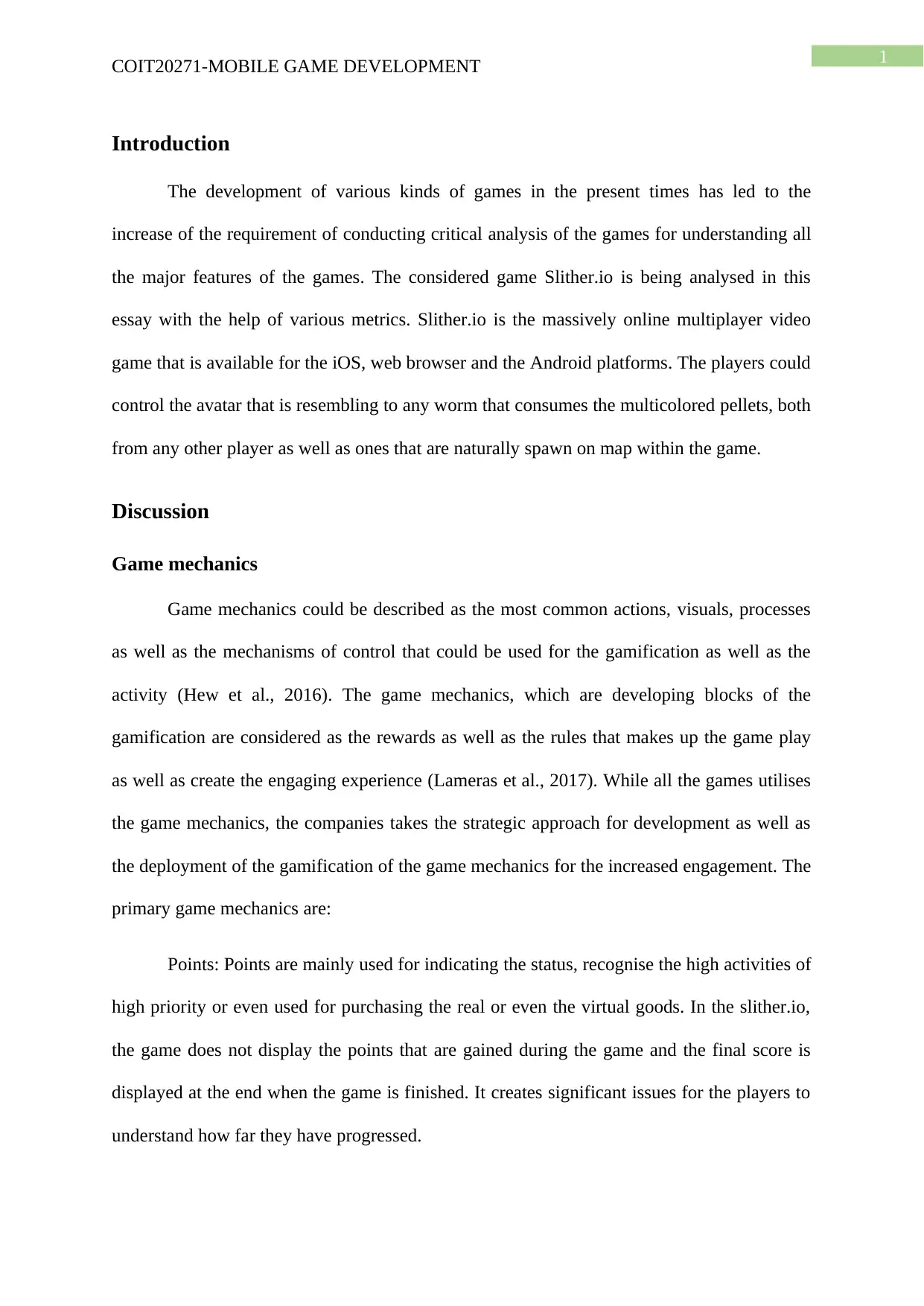
1
COIT20271-MOBILE GAME DEVELOPMENT
Introduction
The development of various kinds of games in the present times has led to the
increase of the requirement of conducting critical analysis of the games for understanding all
the major features of the games. The considered game Slither.io is being analysed in this
essay with the help of various metrics. Slither.io is the massively online multiplayer video
game that is available for the iOS, web browser and the Android platforms. The players could
control the avatar that is resembling to any worm that consumes the multicolored pellets, both
from any other player as well as ones that are naturally spawn on map within the game.
Discussion
Game mechanics
Game mechanics could be described as the most common actions, visuals, processes
as well as the mechanisms of control that could be used for the gamification as well as the
activity (Hew et al., 2016). The game mechanics, which are developing blocks of the
gamification are considered as the rewards as well as the rules that makes up the game play
as well as create the engaging experience (Lameras et al., 2017). While all the games utilises
the game mechanics, the companies takes the strategic approach for development as well as
the deployment of the gamification of the game mechanics for the increased engagement. The
primary game mechanics are:
Points: Points are mainly used for indicating the status, recognise the high activities of
high priority or even used for purchasing the real or even the virtual goods. In the slither.io,
the game does not display the points that are gained during the game and the final score is
displayed at the end when the game is finished. It creates significant issues for the players to
understand how far they have progressed.
COIT20271-MOBILE GAME DEVELOPMENT
Introduction
The development of various kinds of games in the present times has led to the
increase of the requirement of conducting critical analysis of the games for understanding all
the major features of the games. The considered game Slither.io is being analysed in this
essay with the help of various metrics. Slither.io is the massively online multiplayer video
game that is available for the iOS, web browser and the Android platforms. The players could
control the avatar that is resembling to any worm that consumes the multicolored pellets, both
from any other player as well as ones that are naturally spawn on map within the game.
Discussion
Game mechanics
Game mechanics could be described as the most common actions, visuals, processes
as well as the mechanisms of control that could be used for the gamification as well as the
activity (Hew et al., 2016). The game mechanics, which are developing blocks of the
gamification are considered as the rewards as well as the rules that makes up the game play
as well as create the engaging experience (Lameras et al., 2017). While all the games utilises
the game mechanics, the companies takes the strategic approach for development as well as
the deployment of the gamification of the game mechanics for the increased engagement. The
primary game mechanics are:
Points: Points are mainly used for indicating the status, recognise the high activities of
high priority or even used for purchasing the real or even the virtual goods. In the slither.io,
the game does not display the points that are gained during the game and the final score is
displayed at the end when the game is finished. It creates significant issues for the players to
understand how far they have progressed.
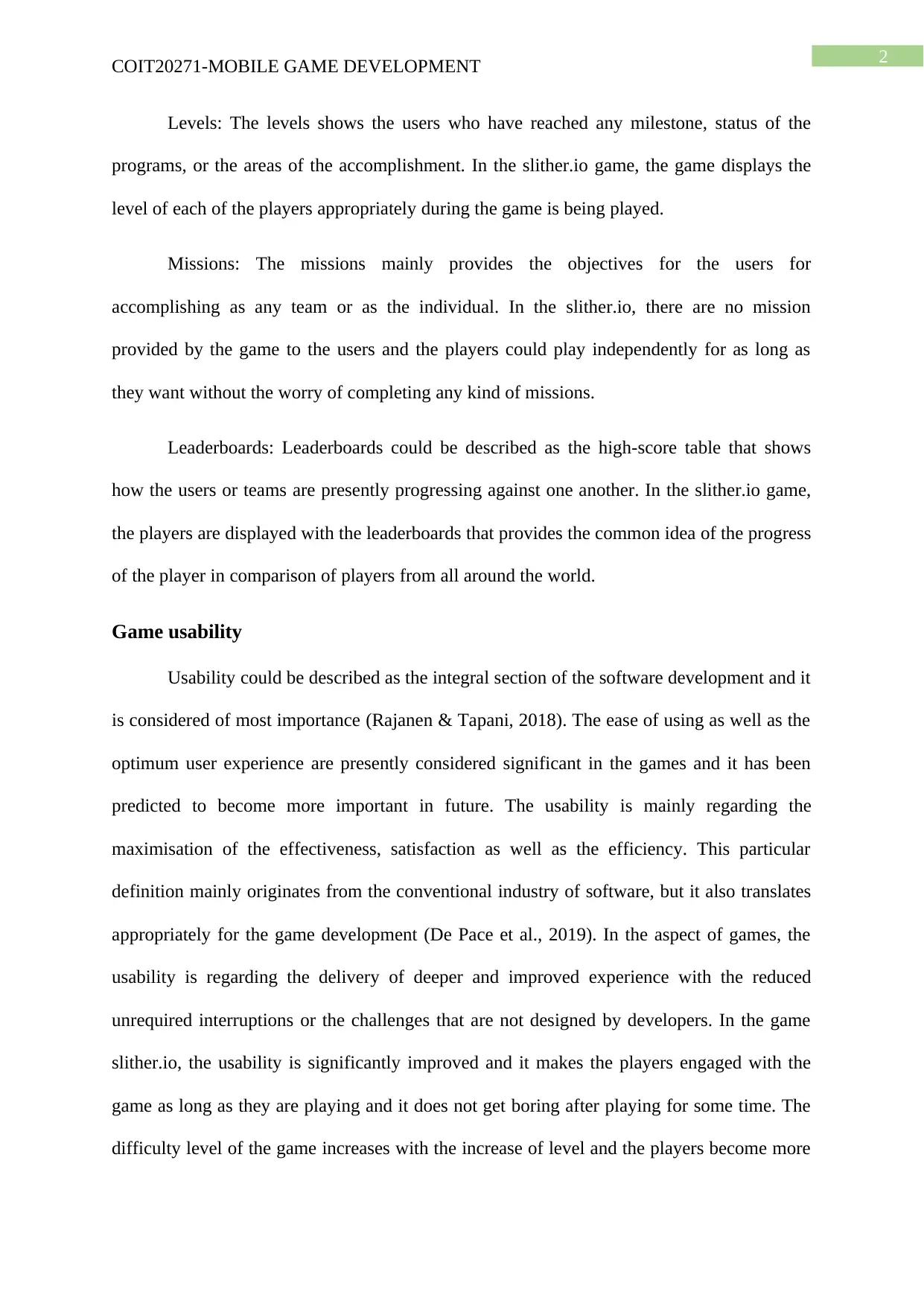
2
COIT20271-MOBILE GAME DEVELOPMENT
Levels: The levels shows the users who have reached any milestone, status of the
programs, or the areas of the accomplishment. In the slither.io game, the game displays the
level of each of the players appropriately during the game is being played.
Missions: The missions mainly provides the objectives for the users for
accomplishing as any team or as the individual. In the slither.io, there are no mission
provided by the game to the users and the players could play independently for as long as
they want without the worry of completing any kind of missions.
Leaderboards: Leaderboards could be described as the high-score table that shows
how the users or teams are presently progressing against one another. In the slither.io game,
the players are displayed with the leaderboards that provides the common idea of the progress
of the player in comparison of players from all around the world.
Game usability
Usability could be described as the integral section of the software development and it
is considered of most importance (Rajanen & Tapani, 2018). The ease of using as well as the
optimum user experience are presently considered significant in the games and it has been
predicted to become more important in future. The usability is mainly regarding the
maximisation of the effectiveness, satisfaction as well as the efficiency. This particular
definition mainly originates from the conventional industry of software, but it also translates
appropriately for the game development (De Pace et al., 2019). In the aspect of games, the
usability is regarding the delivery of deeper and improved experience with the reduced
unrequired interruptions or the challenges that are not designed by developers. In the game
slither.io, the usability is significantly improved and it makes the players engaged with the
game as long as they are playing and it does not get boring after playing for some time. The
difficulty level of the game increases with the increase of level and the players become more
COIT20271-MOBILE GAME DEVELOPMENT
Levels: The levels shows the users who have reached any milestone, status of the
programs, or the areas of the accomplishment. In the slither.io game, the game displays the
level of each of the players appropriately during the game is being played.
Missions: The missions mainly provides the objectives for the users for
accomplishing as any team or as the individual. In the slither.io, there are no mission
provided by the game to the users and the players could play independently for as long as
they want without the worry of completing any kind of missions.
Leaderboards: Leaderboards could be described as the high-score table that shows
how the users or teams are presently progressing against one another. In the slither.io game,
the players are displayed with the leaderboards that provides the common idea of the progress
of the player in comparison of players from all around the world.
Game usability
Usability could be described as the integral section of the software development and it
is considered of most importance (Rajanen & Tapani, 2018). The ease of using as well as the
optimum user experience are presently considered significant in the games and it has been
predicted to become more important in future. The usability is mainly regarding the
maximisation of the effectiveness, satisfaction as well as the efficiency. This particular
definition mainly originates from the conventional industry of software, but it also translates
appropriately for the game development (De Pace et al., 2019). In the aspect of games, the
usability is regarding the delivery of deeper and improved experience with the reduced
unrequired interruptions or the challenges that are not designed by developers. In the game
slither.io, the usability is significantly improved and it makes the players engaged with the
game as long as they are playing and it does not get boring after playing for some time. The
difficulty level of the game increases with the increase of level and the players become more
⊘ This is a preview!⊘
Do you want full access?
Subscribe today to unlock all pages.

Trusted by 1+ million students worldwide
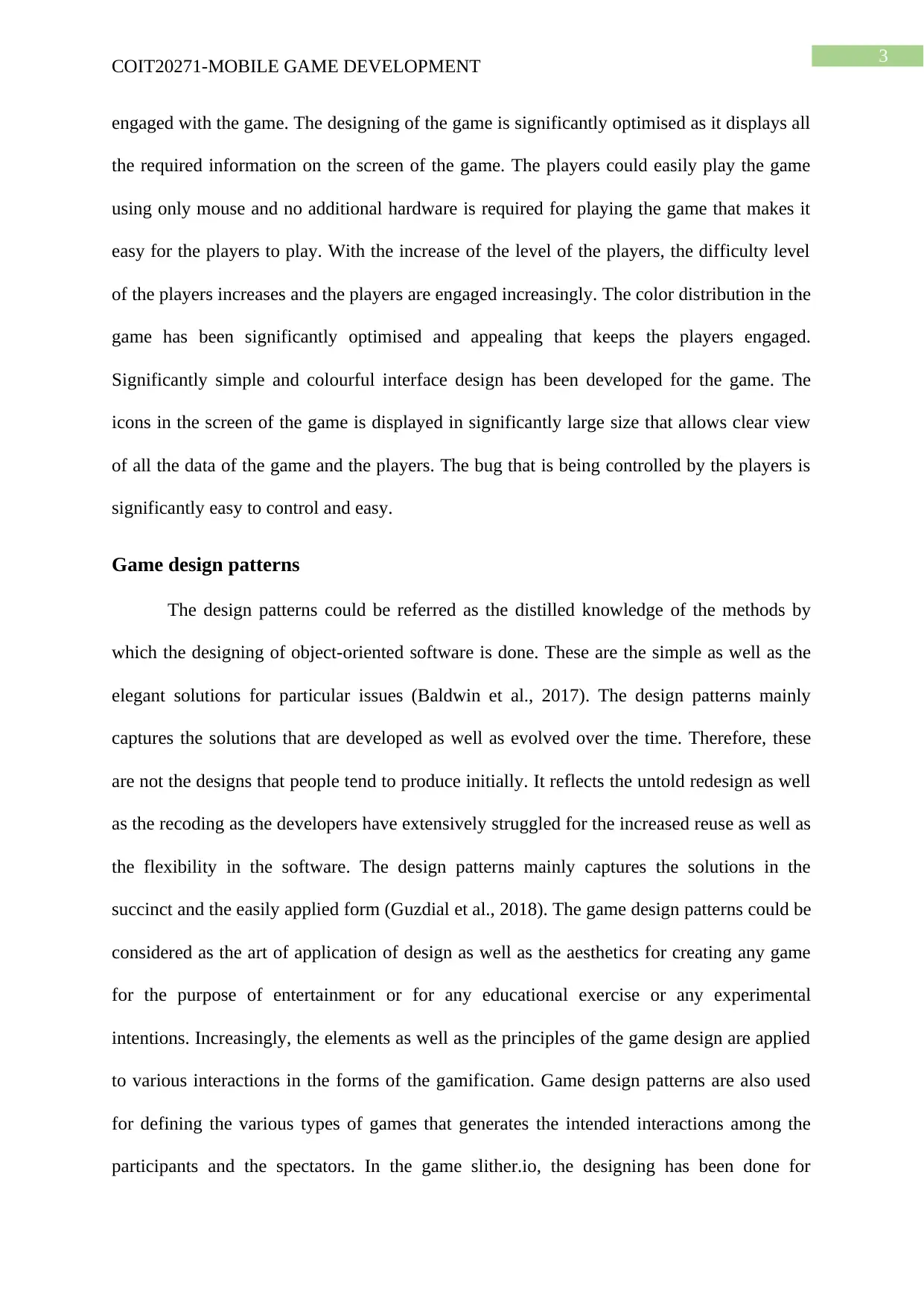
3
COIT20271-MOBILE GAME DEVELOPMENT
engaged with the game. The designing of the game is significantly optimised as it displays all
the required information on the screen of the game. The players could easily play the game
using only mouse and no additional hardware is required for playing the game that makes it
easy for the players to play. With the increase of the level of the players, the difficulty level
of the players increases and the players are engaged increasingly. The color distribution in the
game has been significantly optimised and appealing that keeps the players engaged.
Significantly simple and colourful interface design has been developed for the game. The
icons in the screen of the game is displayed in significantly large size that allows clear view
of all the data of the game and the players. The bug that is being controlled by the players is
significantly easy to control and easy.
Game design patterns
The design patterns could be referred as the distilled knowledge of the methods by
which the designing of object-oriented software is done. These are the simple as well as the
elegant solutions for particular issues (Baldwin et al., 2017). The design patterns mainly
captures the solutions that are developed as well as evolved over the time. Therefore, these
are not the designs that people tend to produce initially. It reflects the untold redesign as well
as the recoding as the developers have extensively struggled for the increased reuse as well as
the flexibility in the software. The design patterns mainly captures the solutions in the
succinct and the easily applied form (Guzdial et al., 2018). The game design patterns could be
considered as the art of application of design as well as the aesthetics for creating any game
for the purpose of entertainment or for any educational exercise or any experimental
intentions. Increasingly, the elements as well as the principles of the game design are applied
to various interactions in the forms of the gamification. Game design patterns are also used
for defining the various types of games that generates the intended interactions among the
participants and the spectators. In the game slither.io, the designing has been done for
COIT20271-MOBILE GAME DEVELOPMENT
engaged with the game. The designing of the game is significantly optimised as it displays all
the required information on the screen of the game. The players could easily play the game
using only mouse and no additional hardware is required for playing the game that makes it
easy for the players to play. With the increase of the level of the players, the difficulty level
of the players increases and the players are engaged increasingly. The color distribution in the
game has been significantly optimised and appealing that keeps the players engaged.
Significantly simple and colourful interface design has been developed for the game. The
icons in the screen of the game is displayed in significantly large size that allows clear view
of all the data of the game and the players. The bug that is being controlled by the players is
significantly easy to control and easy.
Game design patterns
The design patterns could be referred as the distilled knowledge of the methods by
which the designing of object-oriented software is done. These are the simple as well as the
elegant solutions for particular issues (Baldwin et al., 2017). The design patterns mainly
captures the solutions that are developed as well as evolved over the time. Therefore, these
are not the designs that people tend to produce initially. It reflects the untold redesign as well
as the recoding as the developers have extensively struggled for the increased reuse as well as
the flexibility in the software. The design patterns mainly captures the solutions in the
succinct and the easily applied form (Guzdial et al., 2018). The game design patterns could be
considered as the art of application of design as well as the aesthetics for creating any game
for the purpose of entertainment or for any educational exercise or any experimental
intentions. Increasingly, the elements as well as the principles of the game design are applied
to various interactions in the forms of the gamification. Game design patterns are also used
for defining the various types of games that generates the intended interactions among the
participants and the spectators. In the game slither.io, the designing has been done for
Paraphrase This Document
Need a fresh take? Get an instant paraphrase of this document with our AI Paraphraser
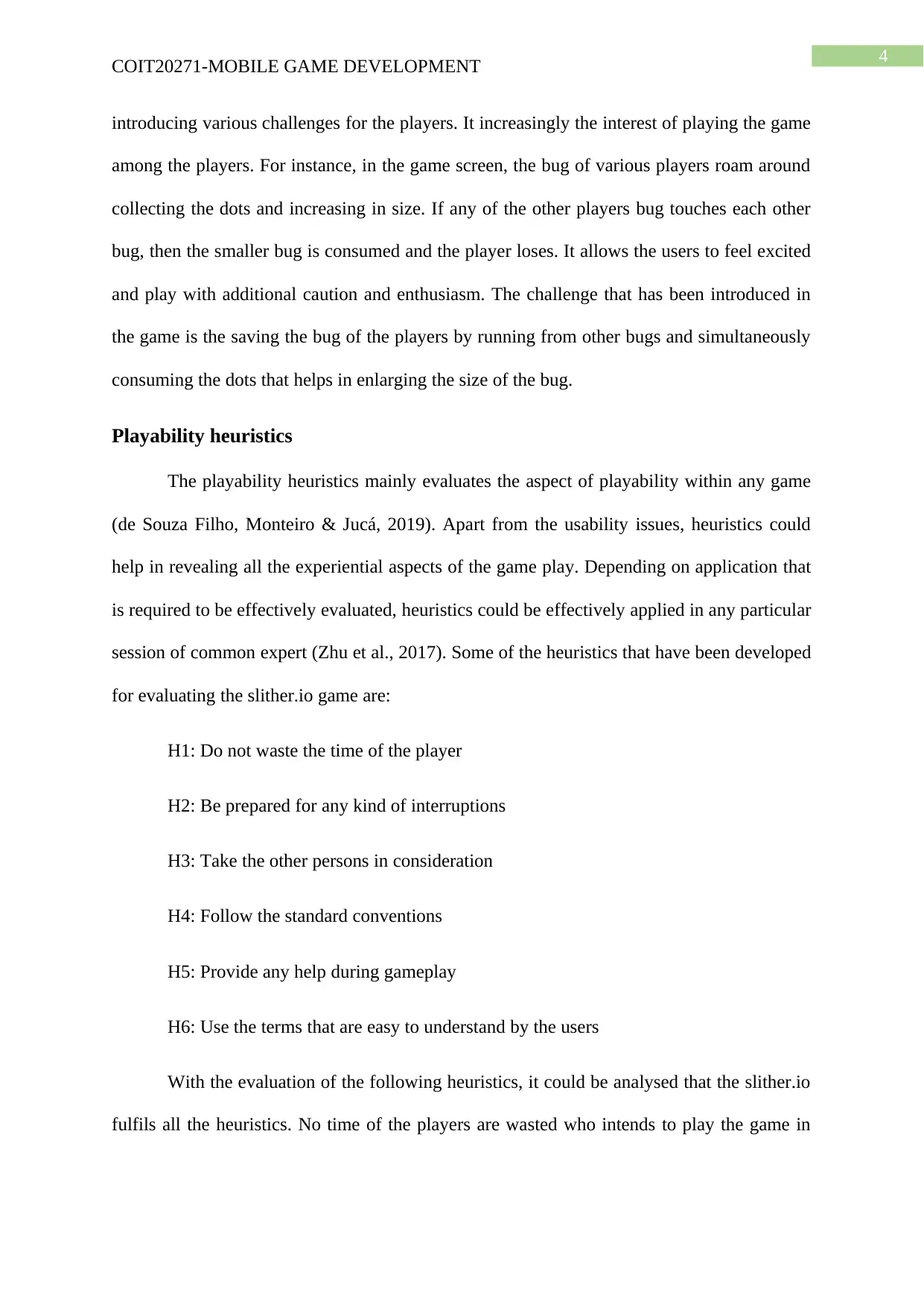
4
COIT20271-MOBILE GAME DEVELOPMENT
introducing various challenges for the players. It increasingly the interest of playing the game
among the players. For instance, in the game screen, the bug of various players roam around
collecting the dots and increasing in size. If any of the other players bug touches each other
bug, then the smaller bug is consumed and the player loses. It allows the users to feel excited
and play with additional caution and enthusiasm. The challenge that has been introduced in
the game is the saving the bug of the players by running from other bugs and simultaneously
consuming the dots that helps in enlarging the size of the bug.
Playability heuristics
The playability heuristics mainly evaluates the aspect of playability within any game
(de Souza Filho, Monteiro & Jucá, 2019). Apart from the usability issues, heuristics could
help in revealing all the experiential aspects of the game play. Depending on application that
is required to be effectively evaluated, heuristics could be effectively applied in any particular
session of common expert (Zhu et al., 2017). Some of the heuristics that have been developed
for evaluating the slither.io game are:
H1: Do not waste the time of the player
H2: Be prepared for any kind of interruptions
H3: Take the other persons in consideration
H4: Follow the standard conventions
H5: Provide any help during gameplay
H6: Use the terms that are easy to understand by the users
With the evaluation of the following heuristics, it could be analysed that the slither.io
fulfils all the heuristics. No time of the players are wasted who intends to play the game in
COIT20271-MOBILE GAME DEVELOPMENT
introducing various challenges for the players. It increasingly the interest of playing the game
among the players. For instance, in the game screen, the bug of various players roam around
collecting the dots and increasing in size. If any of the other players bug touches each other
bug, then the smaller bug is consumed and the player loses. It allows the users to feel excited
and play with additional caution and enthusiasm. The challenge that has been introduced in
the game is the saving the bug of the players by running from other bugs and simultaneously
consuming the dots that helps in enlarging the size of the bug.
Playability heuristics
The playability heuristics mainly evaluates the aspect of playability within any game
(de Souza Filho, Monteiro & Jucá, 2019). Apart from the usability issues, heuristics could
help in revealing all the experiential aspects of the game play. Depending on application that
is required to be effectively evaluated, heuristics could be effectively applied in any particular
session of common expert (Zhu et al., 2017). Some of the heuristics that have been developed
for evaluating the slither.io game are:
H1: Do not waste the time of the player
H2: Be prepared for any kind of interruptions
H3: Take the other persons in consideration
H4: Follow the standard conventions
H5: Provide any help during gameplay
H6: Use the terms that are easy to understand by the users
With the evaluation of the following heuristics, it could be analysed that the slither.io
fulfils all the heuristics. No time of the players are wasted who intends to play the game in
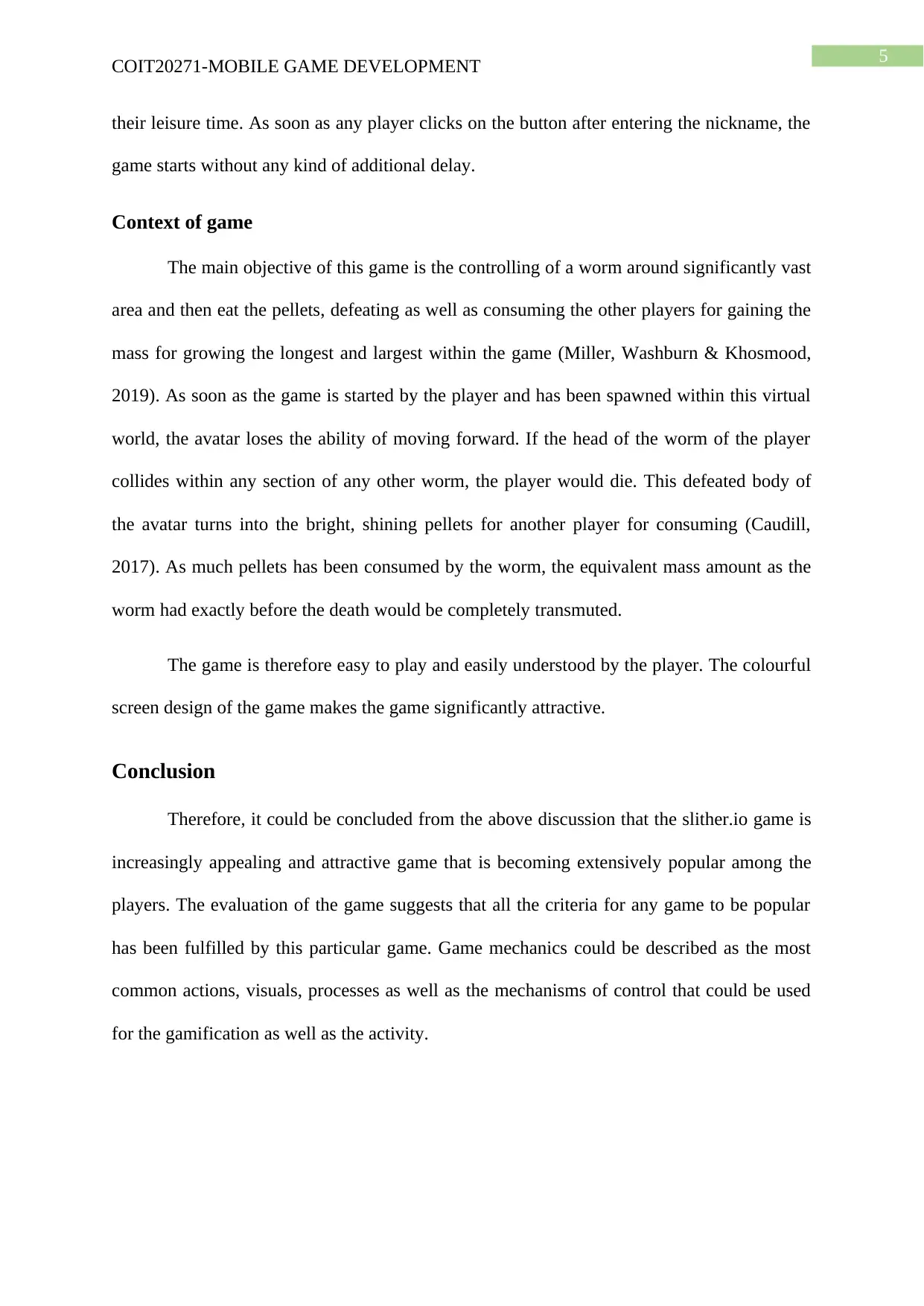
5
COIT20271-MOBILE GAME DEVELOPMENT
their leisure time. As soon as any player clicks on the button after entering the nickname, the
game starts without any kind of additional delay.
Context of game
The main objective of this game is the controlling of a worm around significantly vast
area and then eat the pellets, defeating as well as consuming the other players for gaining the
mass for growing the longest and largest within the game (Miller, Washburn & Khosmood,
2019). As soon as the game is started by the player and has been spawned within this virtual
world, the avatar loses the ability of moving forward. If the head of the worm of the player
collides within any section of any other worm, the player would die. This defeated body of
the avatar turns into the bright, shining pellets for another player for consuming (Caudill,
2017). As much pellets has been consumed by the worm, the equivalent mass amount as the
worm had exactly before the death would be completely transmuted.
The game is therefore easy to play and easily understood by the player. The colourful
screen design of the game makes the game significantly attractive.
Conclusion
Therefore, it could be concluded from the above discussion that the slither.io game is
increasingly appealing and attractive game that is becoming extensively popular among the
players. The evaluation of the game suggests that all the criteria for any game to be popular
has been fulfilled by this particular game. Game mechanics could be described as the most
common actions, visuals, processes as well as the mechanisms of control that could be used
for the gamification as well as the activity.
COIT20271-MOBILE GAME DEVELOPMENT
their leisure time. As soon as any player clicks on the button after entering the nickname, the
game starts without any kind of additional delay.
Context of game
The main objective of this game is the controlling of a worm around significantly vast
area and then eat the pellets, defeating as well as consuming the other players for gaining the
mass for growing the longest and largest within the game (Miller, Washburn & Khosmood,
2019). As soon as the game is started by the player and has been spawned within this virtual
world, the avatar loses the ability of moving forward. If the head of the worm of the player
collides within any section of any other worm, the player would die. This defeated body of
the avatar turns into the bright, shining pellets for another player for consuming (Caudill,
2017). As much pellets has been consumed by the worm, the equivalent mass amount as the
worm had exactly before the death would be completely transmuted.
The game is therefore easy to play and easily understood by the player. The colourful
screen design of the game makes the game significantly attractive.
Conclusion
Therefore, it could be concluded from the above discussion that the slither.io game is
increasingly appealing and attractive game that is becoming extensively popular among the
players. The evaluation of the game suggests that all the criteria for any game to be popular
has been fulfilled by this particular game. Game mechanics could be described as the most
common actions, visuals, processes as well as the mechanisms of control that could be used
for the gamification as well as the activity.
⊘ This is a preview!⊘
Do you want full access?
Subscribe today to unlock all pages.

Trusted by 1+ million students worldwide
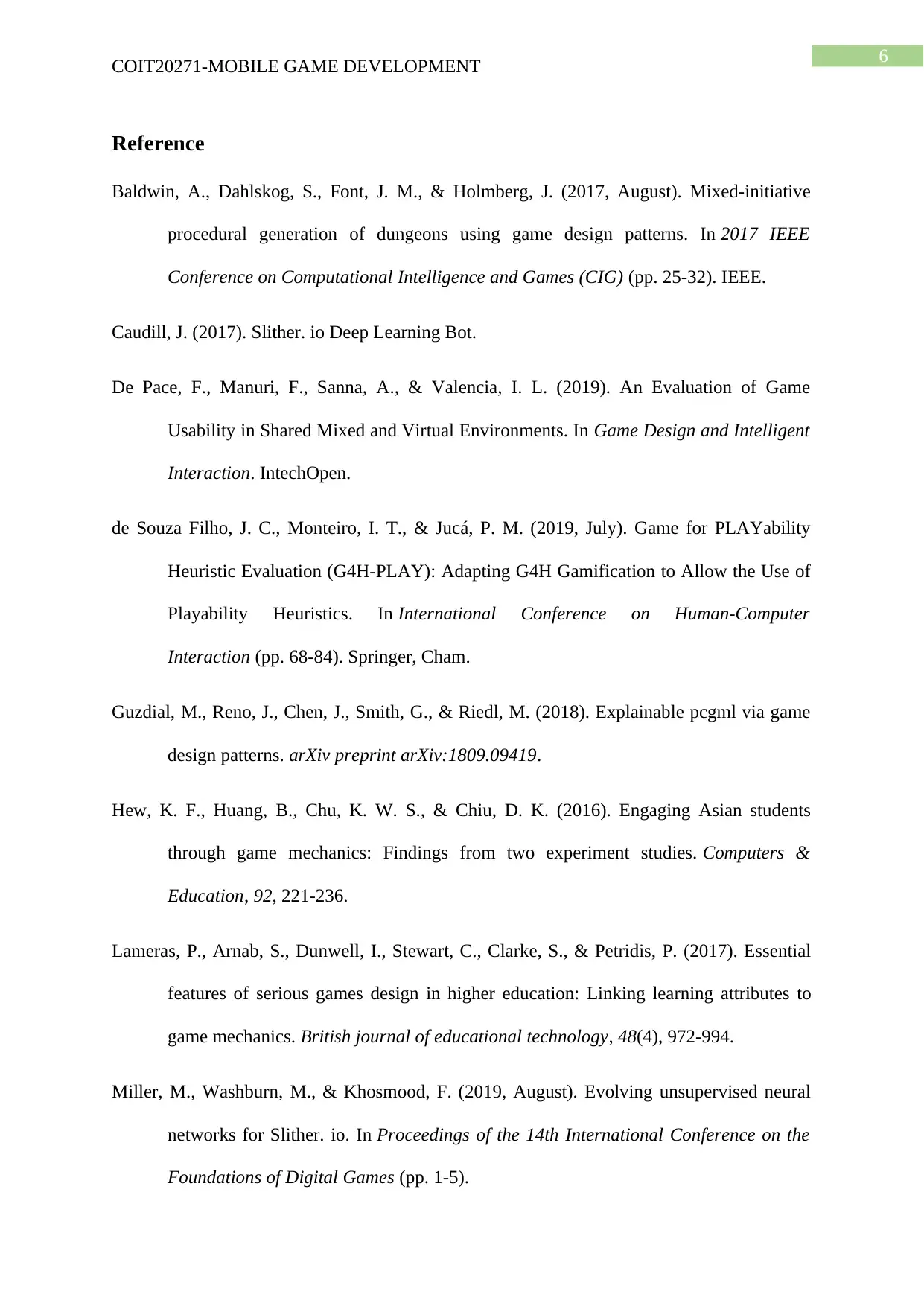
6
COIT20271-MOBILE GAME DEVELOPMENT
Reference
Baldwin, A., Dahlskog, S., Font, J. M., & Holmberg, J. (2017, August). Mixed-initiative
procedural generation of dungeons using game design patterns. In 2017 IEEE
Conference on Computational Intelligence and Games (CIG) (pp. 25-32). IEEE.
Caudill, J. (2017). Slither. io Deep Learning Bot.
De Pace, F., Manuri, F., Sanna, A., & Valencia, I. L. (2019). An Evaluation of Game
Usability in Shared Mixed and Virtual Environments. In Game Design and Intelligent
Interaction. IntechOpen.
de Souza Filho, J. C., Monteiro, I. T., & Jucá, P. M. (2019, July). Game for PLAYability
Heuristic Evaluation (G4H-PLAY): Adapting G4H Gamification to Allow the Use of
Playability Heuristics. In International Conference on Human-Computer
Interaction (pp. 68-84). Springer, Cham.
Guzdial, M., Reno, J., Chen, J., Smith, G., & Riedl, M. (2018). Explainable pcgml via game
design patterns. arXiv preprint arXiv:1809.09419.
Hew, K. F., Huang, B., Chu, K. W. S., & Chiu, D. K. (2016). Engaging Asian students
through game mechanics: Findings from two experiment studies. Computers &
Education, 92, 221-236.
Lameras, P., Arnab, S., Dunwell, I., Stewart, C., Clarke, S., & Petridis, P. (2017). Essential
features of serious games design in higher education: Linking learning attributes to
game mechanics. British journal of educational technology, 48(4), 972-994.
Miller, M., Washburn, M., & Khosmood, F. (2019, August). Evolving unsupervised neural
networks for Slither. io. In Proceedings of the 14th International Conference on the
Foundations of Digital Games (pp. 1-5).
COIT20271-MOBILE GAME DEVELOPMENT
Reference
Baldwin, A., Dahlskog, S., Font, J. M., & Holmberg, J. (2017, August). Mixed-initiative
procedural generation of dungeons using game design patterns. In 2017 IEEE
Conference on Computational Intelligence and Games (CIG) (pp. 25-32). IEEE.
Caudill, J. (2017). Slither. io Deep Learning Bot.
De Pace, F., Manuri, F., Sanna, A., & Valencia, I. L. (2019). An Evaluation of Game
Usability in Shared Mixed and Virtual Environments. In Game Design and Intelligent
Interaction. IntechOpen.
de Souza Filho, J. C., Monteiro, I. T., & Jucá, P. M. (2019, July). Game for PLAYability
Heuristic Evaluation (G4H-PLAY): Adapting G4H Gamification to Allow the Use of
Playability Heuristics. In International Conference on Human-Computer
Interaction (pp. 68-84). Springer, Cham.
Guzdial, M., Reno, J., Chen, J., Smith, G., & Riedl, M. (2018). Explainable pcgml via game
design patterns. arXiv preprint arXiv:1809.09419.
Hew, K. F., Huang, B., Chu, K. W. S., & Chiu, D. K. (2016). Engaging Asian students
through game mechanics: Findings from two experiment studies. Computers &
Education, 92, 221-236.
Lameras, P., Arnab, S., Dunwell, I., Stewart, C., Clarke, S., & Petridis, P. (2017). Essential
features of serious games design in higher education: Linking learning attributes to
game mechanics. British journal of educational technology, 48(4), 972-994.
Miller, M., Washburn, M., & Khosmood, F. (2019, August). Evolving unsupervised neural
networks for Slither. io. In Proceedings of the 14th International Conference on the
Foundations of Digital Games (pp. 1-5).
Paraphrase This Document
Need a fresh take? Get an instant paraphrase of this document with our AI Paraphraser

7
COIT20271-MOBILE GAME DEVELOPMENT
Rajanen, M., & Tapani, J. (2018). A Survey of Game Usability Practices in North American
Game Companies.
Zhu, M., Zhao, F., Fang, X., & Moser, C. (2017). Developing playability heuristics based on
nouns and adjectives from online game reviews. International Journal of Human–
Computer Interaction, 33(3), 241-253.
COIT20271-MOBILE GAME DEVELOPMENT
Rajanen, M., & Tapani, J. (2018). A Survey of Game Usability Practices in North American
Game Companies.
Zhu, M., Zhao, F., Fang, X., & Moser, C. (2017). Developing playability heuristics based on
nouns and adjectives from online game reviews. International Journal of Human–
Computer Interaction, 33(3), 241-253.
1 out of 8
Your All-in-One AI-Powered Toolkit for Academic Success.
+13062052269
info@desklib.com
Available 24*7 on WhatsApp / Email
![[object Object]](/_next/static/media/star-bottom.7253800d.svg)
Unlock your academic potential
Copyright © 2020–2025 A2Z Services. All Rights Reserved. Developed and managed by ZUCOL.


